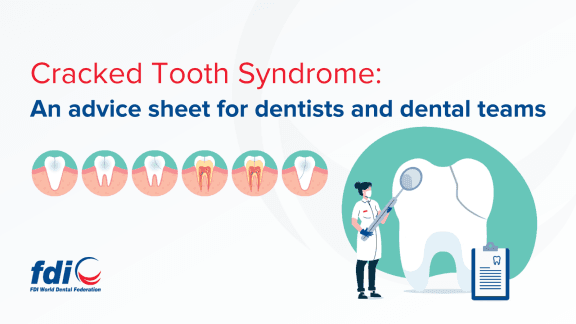Switzerland: New recommendations for Cracked Tooth Syndrome(CTS), a transient and degenerative disorder, have been released by the FDI.

Cracked teeth are frequently seen during dental surgery. It can be challenging to diagnose CTS, it needs proper care, and if it is not, it could eventually result in tooth loss.
Cracked teeth are frequently seen during dental surgery. From modest enamel chips to severe fractures that result in tooth loss, a crack can range in severity.
When a cusp completely separates from a tooth, most fractures are referred to as "complete" fractures. When the fractured portion of the tooth is still joined to the rest of the tooth by a bridge of healthy tissue, the minority are known as "incomplete" fractures. Patients may experience uncomfortable symptoms which are difficult to describe in case of these incomplete fractures.
What is a cracked tooth?
A cracked tooth is an incomplete fracture when a crack runs from the occlusal surface of the tooth down towards the root without breaking apart. Sometimes it goes below the gum line and into the root. The pulp of the cracked tooth is usually damaged.
Causes:
- A cracked tooth is often caused by trauma or tooth wear from teeth grinding or clenching, which is often a symptom of stress.
- Cases of cracked teeth and tooth-related injuries, as well as cases of bruxism or teeth grinding, have increased during the COVID-19 pandemic. This may be, at least in part, due to pandemic-related stress damaging oral health.
Diagnosis:
An early diagnosis is crucial for effective treatment. Cracks may be symptomatic, supporting a CTS diagnosis, or asymptomatic, not supporting one.
There is frequently a history of masticatory pain and sensitivity to thermal stimuli (mostly cold) or sugary foods and beverages.
The patient can also exhibit the following symptoms:
- Bruxism,
- Trismus,
- Sore facial muscles,
- Temporomandibular joint dysfunction (TMJ),
- Loss or displacement of restorations,
- Abrasion,
- Abfraction,
- Worn facets,
- Generalized sensitivity,
- Tooth movement.
The pulp or periodontium may become secondary involved as a result of a crack.
The cracked tooth syndrome can be identified with the tooth sleuth. The patient is told to bite and squeeze their teeth together for a short period of time once the thick end of the tooth probe has been introduced to the investigated tooth cusp. When the pressure is released, the patient feels pain if the tooth has a crack.
Transillumination, which is the process of projecting a bright beam of light through a specimen and analyzing the pattern of light transmission, is one method for identifying a cracked tooth. When a tooth cracks, light enters through the gap and is distributed, so it doesn't cross over and reflect on the side beyond the crack of the tooth.
What are the preventive measures for CTS?
FDI recommends the following measures to be recommended to patients in order to prevent the initiation and progression of cracks in the teeth:
- Exercise caution when eating unpitted olives, cherries, or seeded bread.
- Avoid chewing hard objects such as fingernails, pen tops, and other habits.
- Avoid clenching or grinding their teeth.
- Use retainers or mouthguards to protect their teeth during sleep.
- Wear a mouthguard or face shield during sports.
- Reduce or avoid if possible psychological stress that increases clenching or grinding of teeth. To seek professional psychological support if required.
- Undergo evaluation and correction of occlusal interference.
- Attend regular dental appointments to allow for the examination of occlusal and contact points regularly.
What is the treatment of cracked tooth syndrome?
The tooth can be treated with a root canal and crown if the crack has reached the pulp in order to stop it from spreading.
However, it may be more difficult to restore if the crack spreads below the gum line. Early treatment is crucial as it will gradually get worse and eventually cause tooth loss if not treated on time.
A cracked tooth will eventually develop into a split tooth over time. However, whether any part of the tooth can be preserved will depend on where the crack is and how big it is. Endodontic therapy may be used in some situations to preserve a part of the split tooth.
Cracks that begin at the tooth's root and progress to the occlusal surface are referred to as vertical root fractures. They rarely show symptoms at an early stage which increases the likelihood of going unnoticed until the later stage.
Localized gingivae that are inflamed or infected may indicate a vertical root fracture, periodontal pockets, or related bone loss.
Some cracks may continue to progress even after the treatment, leading to tooth loss. Although placing a crown on a broken tooth offers the greatest protection, it is not always successful. There have been cases where appropriately treated cracked teeth have been in function for years. Therefore it is advisable to always take a chance to treat the tooth if possible.
However, the patient should be informed of a guarded prognosis of the tooth.
Source: fdiworlddental.org
Download Adice sheet by clicking here




















Comments